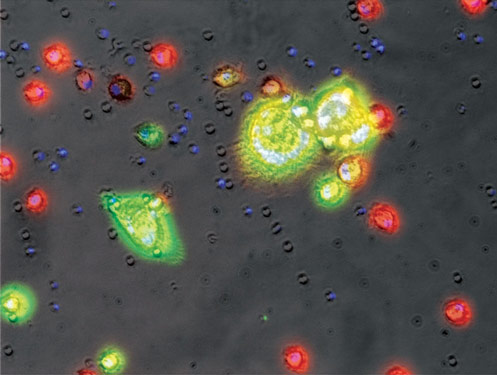Appearance of HIV in the early warning system – camouflage uncovered
While the human immunodeficiency virus replicates extremely rapidly in some of the human immune cells, other cells remain unaffected. Researchers of the Paul-Ehrlich-Institut have been able to identify how monocytes protect themselves from an HIV infection. In this context, the protein SAMHD1 plays a key role. In addition, the investigators were able to show by means of blood samples from patients with a rare congenital disease that the absence of SAMHD1 makes early detection of the virus possible via the immune system. PLoS Pathogens reports on the research results in its online issue of December 8, 2012 (CET: December 9, 2012, 01.00).
The generally feared human immunodeficiency virus very efficiently infects T lymphocytes, a special cell group of the immune system, in the human organism. On the other hand, myeloid blood cells, such as dendritic cells, monocytes, and partly macrophages, which also serve to support immune responses, provide natural protection against HIV-1. Researchers at the Paul-Ehrlich-Institut (PEI) under the supervision of Dr Egbert Flory, head of the section "Tissue Engineering and Somatic cell therapeutics" in the Division Medical Biotechnology and research group leader Professor Renate König have now proved that the cellular protein SAMHD1 ("SAM domain and HD domain containing protein 1") is responsible if monocytes are not infected by the human immunodeficiency virus. This 'protective function' of SAMHD1 can, however, be switched off in the non-infectable cells, if viral protein X (Vpx) is inserted into the cells, as the scientists at the PEI were able to show. Vpx interacts with SAMHD1 which causes the latter to disintegrate. As a result, the previously HIV-1-resistant cells become infectable. In further experiments, the researchers used a mutated Vpx variant. This variant is no longer able to bind to SAMHD1 and is thus no longer able to induce disintegration of the protein. In these experiments, no infection developed. These experiments support previously published findings of two other research teams who described the significance of SAMHD2 as restrictive factor in an HIV-1-infection for dendritic cells and macrophages.
 Monocytes infected with HIV-1 (yellow-green) and non-infected monocytes (red). The cells originate from patients with the rare Aicardi-Goutières syndrome and were infected in cell culture. These cells do not have a functioning SAMHD1 and can therefore be infected by HIV-1.
Source: Prof. Viviana Simon, Department of Microbiology, Mount Sinai School of Medicine, New York
Monocytes infected with HIV-1 (yellow-green) and non-infected monocytes (red). The cells originate from patients with the rare Aicardi-Goutières syndrome and were infected in cell culture. These cells do not have a functioning SAMHD1 and can therefore be infected by HIV-1.
Source: Prof. Viviana Simon, Department of Microbiology, Mount Sinai School of Medicine, New York
The researchers of the PEI went one step further: In collaboration with Prof. Frank Rutsch, University Hospital Münster, and researchers of the Mount Sinai School of Medicine at New York under the supervision of Professor Viviana Simon and Professor Ana Fernandez-Sesma, they investigated how monocytes of patients with the very rare Aicardi-Goutières syndrome reacted to the human immunodeficiency virus. Due to a mutation, the cells of the patient suffering from this serious congenital disease lack the functional SMHD1 protein: "While monocytes cannot normally be infected by HIV at all, these cells revealed massive replication of the virus. A very important finding, above all, is that, here too, a first early response of the immune cells to the virus was recognisable"
, explained König. While in the case of influenza viruses, a rapid first immune response of the infected cells is induced with interferon release, because the viral RNA is recognised as foreign when entering the cell, the immunodeficiency virus escapes this early response phase unnoticed.
"This finding is of great significance for the development of vaccines against HIV infections"
, emphasised Professor Klaus Cichutek, president of the PEI. "Previous investigations have been of little success because no suitable immune response was induced by the potential vaccine candidates. Understanding the early camouflage mechanism of the virus may help us identify new approaches to finding a better immune response"
. In addition, with SAMHD1, an important key to a system has been found which protects cells from an HIV infection.
Original publications:
Berger A, Sommer AFR, Zwarg J, Hamdorf M, Welzel K, Esly N, Panitz S, Reuter A, Ramos I, Jatiani A, Mulder LCF, Fernandez-Sesma A, Rutsch F, Simon V, König R, Flory E (2011): SAMHD1-deficient CD14+ cells from individuals with Aicardi-Goutières syndrome are highly susceptible to HIV-1 infection.
PLoS Pathog 7: e1002425.
Text
Press Contact:
Paul-Ehrlich-Institut
Press Office
Dr. Susanne Stöcker, Dr. Corinna Volz-Zang, Brigitte Morgenroth
Paul-Ehrlich-Straße 51-59
63225 Langen
GERMANY
Telefon: +49 6103 77 1030
Telefax: +49 6103 77 1262
Email: presse@pei.de
top



